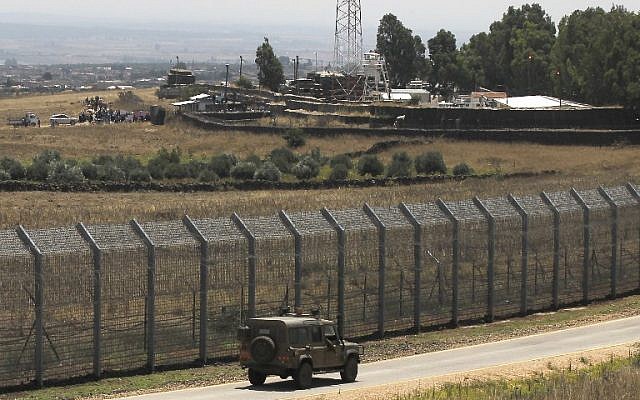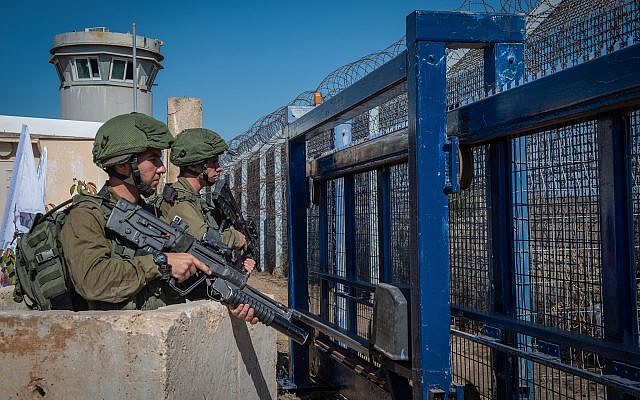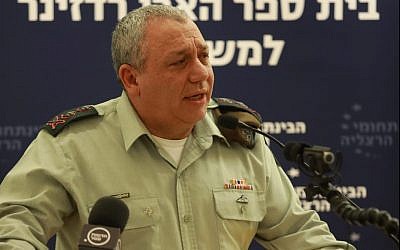Army working to determine if suspects crossed 1974 ceasefire line for intelligence-gathering purposes; no Israeli injuries reported

IDF soldiers opened fire at a group of gunmen who crossed the 1974 ceasefire line in the Golan Heights and were approaching Israel’s border fence from Syria, the army said Sunday night.
No Israeli injuries were reported in the incident and the IDF was working to determine whether the unidentified individuals had been on an intelligence-gathering operation.
The 1974 ceasefire accord marked the end of the previous year’s Yom Kippur War and established a buffer zone between Israel and Syria. The area closest to the border became a full demilitarized zone, where only the United Nations Disengagement Observer Force and police could operate, while the rest of the buffer zone had strict limits on the number and types of military units and equipment allowed inside it.
The gunmen were said to have entered the demilitarized zone, but did not cross the border with Israel.
In October a border crossing between enemy nations Syria and Israel reopened at Quneitra, four years after it closed as UN observers fled the area due to fierce fighting in the Syrian civil war. The move marked a de facto recognition by Israel that dictator President Bashar Assad has returned to govern in southern Syria, after he defeated rebel groups in the area earlier this summer.

Sunday’s incident comes just days after US President Donald Trump shocked the world — and his own defense and foreign policy officials — by declaring that the US had fulfilled its mission in Syria of defeating the Islamic State terror group and was therefore planning to remove its troops from the country. Defense analysts and officials from around the world largely rejected the claim that IS had been defeated, citing the terror group’s thousands of fighters still operating inside Syria despite its territorial losses.
Israel’s Channel 10 news reported that Prime Minister Benjamin Netanyahu tried in vain to persuade Trump to change his mind, and that there was tremendous “disappointment” in Jerusalem over the pullout, which is regarded as a victory for Russia, Iran and Hezbollah.
The TV report described the US move as “a slap in the face” for Israel, noting that the US presence in Syria was “the only bargaining chip” in Israel’s efforts to persuade Russia to prevent Iran deepening its entrenchment in Syria.
For Israel, the pullout leaves it without a staunch ally in the fight against Iran in Syria and potentially opens the door for the Islamic Republic to create a so-called “land bridge” from Iran, through Iraq and Syria, into Lebanon and the Mediterranean Sea.
Until now, American troops have been stationed in northeastern Syria, along the Iraqi border, blocking such a corridor, through which Iran could more easily distribute advanced weapons and technology throughout the region, especially to its Lebanese client the Hezbollah terrorist army.

Earlier on Sunday, IDF Chief of Staff Gadi Eisenkot called the White House’s decision to pull its troops from Syria a “significant event,” but said the Israeli military would continue to independently fight Iran’s military presence in the neighboring country.
In August, the IDF said it conducted an airstrike that killed seven Islamic State fighters who had crossed the ceasefire line. The gunmen had made it some 200 meters (650 feet) past the “alpha line” but did not manage to reach the technical fence bordering the Israeli Golan Heights, IDF spokesman Jonathan Conricus said.
A number of explosive belts and a Kalashnikov rifle were later found during searches of the area, according to the army.
Those gunmen had crossed into the Israeli territory through the Syria-Jordan-Israel border triangle.
The army later released a short clip showing the IS gunmen heading toward Israel and Israeli soldiers crossing into no-man’s land to search for them. Conricus said that there had been no threat to Israeli communities along the northern border, but he did not say whether the IS gunmen were intending to attack Israeli military targets.
As reported by The Times of Israel
